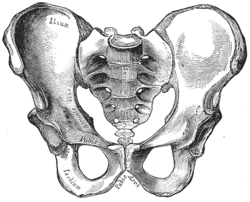type of joint between pelvic bones in the pelvic girdle
In human anatomy, the pelvis (plural pelves or pelvises, sometimes also called pelvic region of the trunk) is the lower part of the trunk, between the abdomen and the lower limbs (legs).[1] The pelvis includes several structures:[1]
- the bony pelvis, or pelvic skeleton, the part of the skeleton connecting the sacrum region of the spine to the femurs, subdivided into:
- the pelvic girdle (the two hip bones, which are part of the appendicular skeleton) and
- the pelvic region of the spine (sacrum, and coccyx, which are part of the axial skeleton)
- the pelvic cavity, typically defined as a small part of the space enclosed by the pelvic skeleton, delimited by the pelvic brim above and thepelvic floor below; alternatively, the pelvic cavity is sometimes also defined as the whole space enclosed by the pelvic skeleton, subdivided into:
- the greater or false pelvis, above the pelvic brim
- the lesser or true pelvis, below the pelvic brim
- the pelvic floor or pelvic diaphragm, below the pelvic cavity
- the perineum, below the pelvic diaphragm
In the human, the pelvic skeleton is formed in the area of the back (posterior dorsal), by the sacrum and the coccyx (the caudal portion of the axial skeleton), and laterally and anteriorly (forward and to the side), by a pair of hip bones, the lower extremity, (parts of the appendicular skeleton). In an adult human being, the pelvic skeleton is thus composed of three large bones, and the coccyx (3–5 bones); however, before puberty, each hip bone consists of three discrete (separate) bones — the ilium, ischium, pubis — that have yet to fuse at adulthood; thus, in puberty, the human pelvic skeleton can comprise more than 10 bones, depending upon the composition of the person’s coccyx.
| Female type pelvis | |
| Male type pelvis | |



